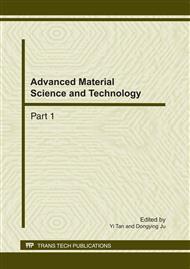p.1053
p.1061
p.1065
p.1069
p.1073
p.1077
p.1081
p.1085
p.1089
Study on Ultra-Strength Mortar Prepared with Mineral Admixture
Abstract:
In this paper, preparation, property study of ultra-strength mortars with mineral admixture and clear river sand was carried out. The mineral admixture include fly ash, ultra-fine GGBS and silica fume. The experimental results show that the compressive strength of mortar improves with increasing amount of silica fume or ultra-fine GGBS. When the content of silica fume or ultra-fine GGBS is 30~35%, the compressive strength and flexural strength of mortar in curing age of 7 days are 100 MPa and 20MPa, respectively. But strength of mortar decreases with the increase replacement rate of fly ash. When the mortar mixes with combined of silica fume and ultra-fine GGBS, the optimum proportion of siliaca fume to ultra-fine GGBS is 2:3. And the compressive strength of mortar in curing age of 7 days is 75~100MPa when the mixed mineral admixture is 40~60%. The compressive strength of mortar is about 90MPa as it mix 60% of cement, 15% of silica fume, 15% of GGBS and 10% of fly ash. Moreover, the ultra strength mortar refines its pore structure and its capiliary pore (≥100nm) amount reduces by 78% compared to ordinary mortar.
Info:
Periodical:
Pages:
1073-1076
Citation:
Online since:
February 2011
Authors:
Keywords:
Price:
Сopyright:
© 2011 Trans Tech Publications Ltd. All Rights Reserved
Share:
Citation:


